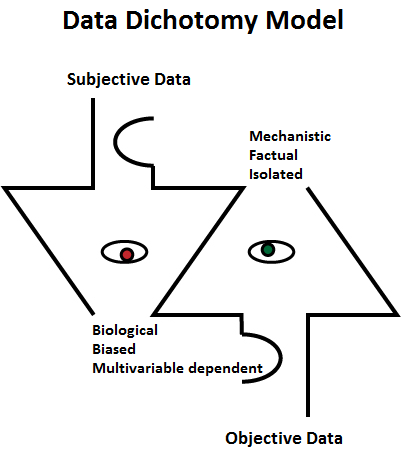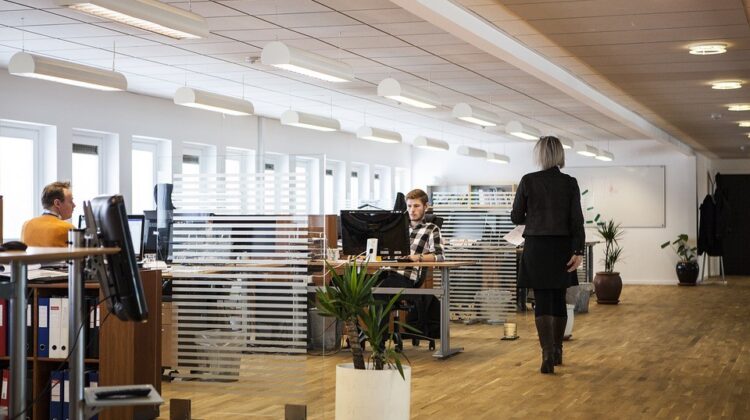
Our editor Morten Roar Berg, Concept Developer for Office in Denmark, attended Euronoise in Crete – and here are his main takeaway points from the session: Room Acoustic Design and Psychological effects of offices.
Once again office noise was on the agenda at EuroNoise 2018. Although a persistent problem one’s spirit couldn’t help but be lifted a little by the quality of the presentations, the rigorous questions from the audience and the general positivity of the room. Judging by the first structured session in The Crete Conference Center we are well on our way to thoroughly understanding, handling and preventing problems of office noise. Here are my thoughts on the three of the most important presentations in my view.
Holistic Study Design – Acoustics, temperature and ventilation
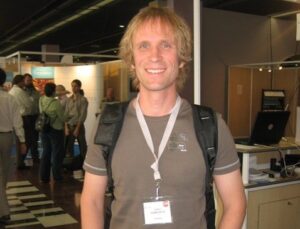
Valtteri Hongisto stepped down from the position of chair of the session and presented his complex multivariable study. The variables included the most commonly reported problematic environmental factors: high temperature, insufficient ventilation and irrelevant speech. As Mr. Hongisto noted, most studies investigate these factors independently, but good data on their holistic effect on cognitive performance is lacking. In his opinion a holistic approach to the effects of office design is necessary, also in the field of acoustics.
The study was split between two testing conditions in an otherwise normal looking office setting. Sixty-five participants were tested and all of them in both scenarios. The subjects worked in teams of six and in periods of two hours. During the experiment the subjects were presented with 6 different assignments and several questionnaires.
The indoor environment was significantly worsened from condition A to condition B as shown in table 1. Four loudspeakers were distributed in the corners of the offices playing back clear speech while the subjects worked. 93 m2 of class A-absorbers was removed from the office from condition A to B. Hidden radiators under the corner workstations was turned on and ventilation exhaust was recirculated back into the room in condition B.
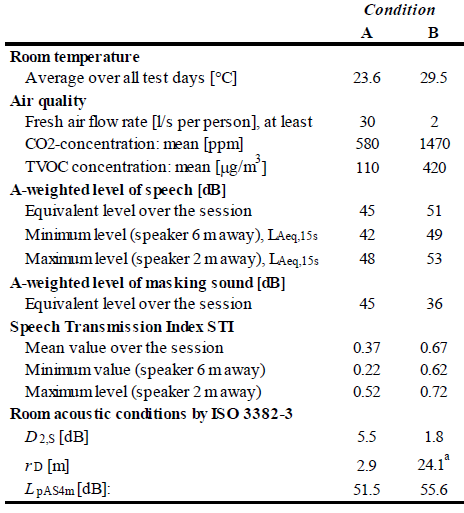
The performance of the subjects was evaluated through distributing the 6 types of tasks over a wide range of different types of office work. As suspected the results from these tasks showed significantly worse performance under condition B. The questionnaires collected the subjective experience of the participants in regards to the different elements of annoyance present in the room.
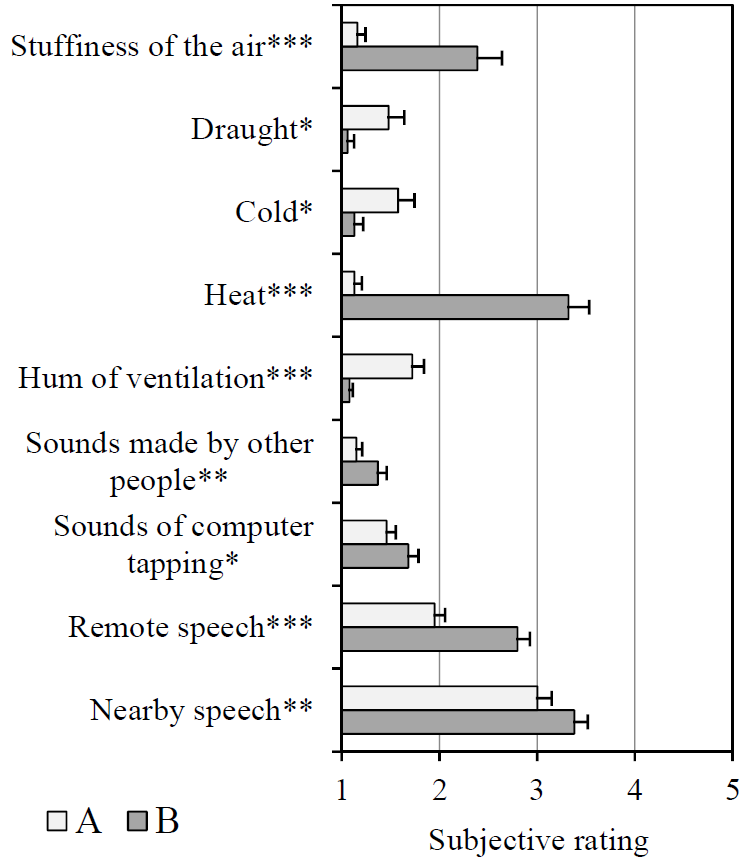
Surprisingly, speech was reported as the worst annoyance even under the quite severely inadequate regulation of heat and ventilation (Figure 2). Heat and ventilation is often pre-assumed to be the worst types of annoyances. This once again proves how important acoustics in open offices are for the wellbeing of the workers as well as the original principle of this complex study – that it is important to also study complex environments as open offices holistically though multivariable means.
As Mr. Hongisto pointed out in his final remarks much information of interconnected phenomena can be missed by only using narrowly focused investigation techniques. No methodology for holistic multivariable studies was implemented in this study.
Study: “Effect of room acoustics, temperature and ventilation on work performance in open-plan offices.”
Contributors: Hongisto Valtteri, Maula Henna, Koskela Hannu, Haapakangas Annu, Hakala Jarkko.
More articles mentioning Valtteri Hongisto:
https://www.acousticbulletin.com/more-open-plan-office-acoustics
https://www.acousticbulletin.com/interview-with-valtteri-hongisto-from-the-finnish-institute-of-occupational-health
—————————————————-
Fatigue and annoyance due to noise under realistic conditions
Krist Kostallari began his impressive presentation of his new study with a quick overview of guiding perspectives for the design of the study:
- Even when standards are upheld people can be severely disturbed by acoustic conditions.
- The problem of office acoustics is more complex than just dB(A).
- Serial recall task is not enough evaluating for performance in relation to real office tasks.
- More realistic tests are needed to evaluate the effects of acoustic conditions on cognitive performance.
- Ideally subjects should be studied over the course of a complete workday to evaluate the complete effect of different acoustic conditions.
No matter how clear, precise and understandable these points are they do simultaneously put up considerable demands on a given study design. This didn’t prevent Mr. Kostallari from taking on this challenge however. He mentioned that carrying out the experiment took about a month of worktime in total. The study evaluated 39 test subjects over 3 complete workdays, in three different sound environments.
During the experiment the participants were working with different assignments and with specific parameters being evaluated. In addition, they were also asked to rate their physiological state subjectively through questionnaires regarding aspects like tiredness, mental fatigue, etc. In addition, they were also subjected to a serial recall test to assess the load effect of working memory.
The three sound environments consisted of a condition of homogeneous noise, noise modulated to emulate human speech intervals and clear speech. Overall performance was worse in the condition with speech but not extensively, although written words pr. Time interval was dramatically lowered in conditions with speech.
Interestingly this study seems to show a significant correlation between subjective and objective measurements of performance which is often an important point in the study of acoustics as many still does not trust the subjective reports of workers.
Mr. Kostallari could conclude that acoustic conditions do seem to have a distinct effect over al long term period which should be kept in mind in the investigation of office acoustics.
Study: Fatigue and Annoyance due to noise in open-plan offices: A laboratory study.
Contributors: Kostallari Krist, Parizet Etienne, Chevret Patrick, Amato Jean-Noël, Galy Edith
—————————————————-
The overlooked psychometric and neurophysiological dimension of acoustics
Tania Barney and Ecophon’s Paige Hodsman took the stage to present some of the findings of their extensive literature review.

Paige began the presentation with a precise summation of the persistent problem of office acoustics. She then proceeded to give a brief introduction to her work with Nigel Oseland on the psychoacoustic aspects office design. Simply put, this work investigates psychological difference of temperament in relation to acoustics and practical application of this knowledge in office design. In short they find a consistent relation between quantifiably personality aspects and sensitivity to acoustics.

Mrs. Barney took to the stage to introduce the added context she contributes to the work of Hodsman and Oseland. Namely, a comprehensive background in neurophysiological sensory profiling, which adds another layer of precision to this dawning understanding of individual differences in reactions to noise.
Roughly speaking, there are several types of sensory profiles that react differently to types and power of stimuli and also varies in habituation time. Sensory profiles can be used reliably to predict outcomes of test subjects reactions to stimuli, but does not correlate directly to the above mentioned psychological aspects.
Unfortunately, the presentation was cut short and the two speakers didn’t get the chance to present the key takeaways as forcefully as their impressive research deserves. This is generally an overlooked dimension of acoustic research that could bend or break the validity of many studies.
If, for instance, results of annoyance experiments can be reliably predicted through the work of Hodsman, Oseland & Barney researchers must begin to take special care in preselecting participants for studies in the future.
To be sure, this blog post cannot do Barney and Hodsman’s refined and nuanced work justice. This is should only be regarded as a teaser.
Study: One size does not fit all: Neurophysiological factors in office design.
Contributers: Barney Tania, Holdsman Paige.
For more information about the session, please contact Morten Roar Berg.

